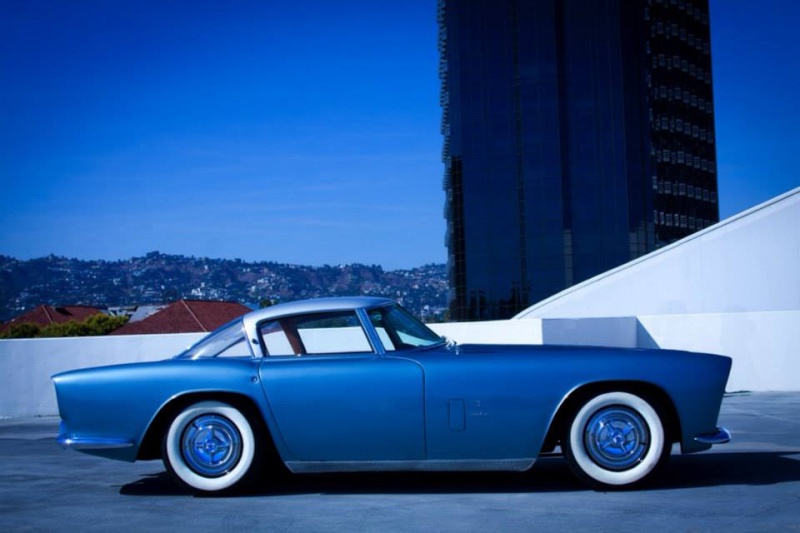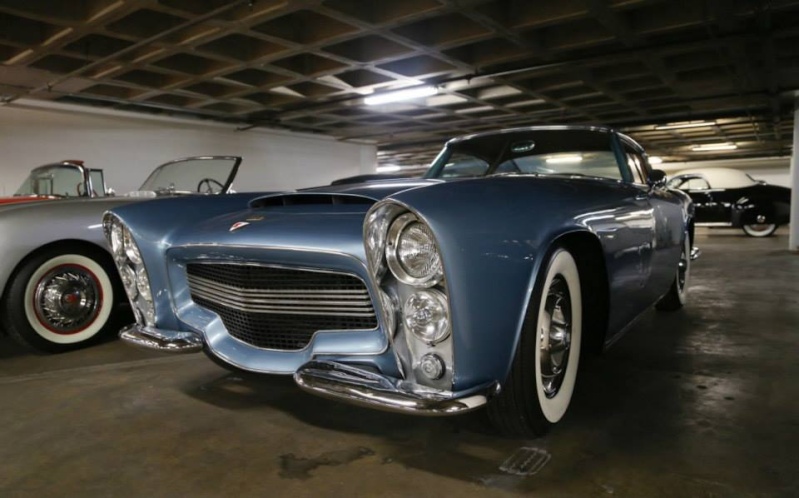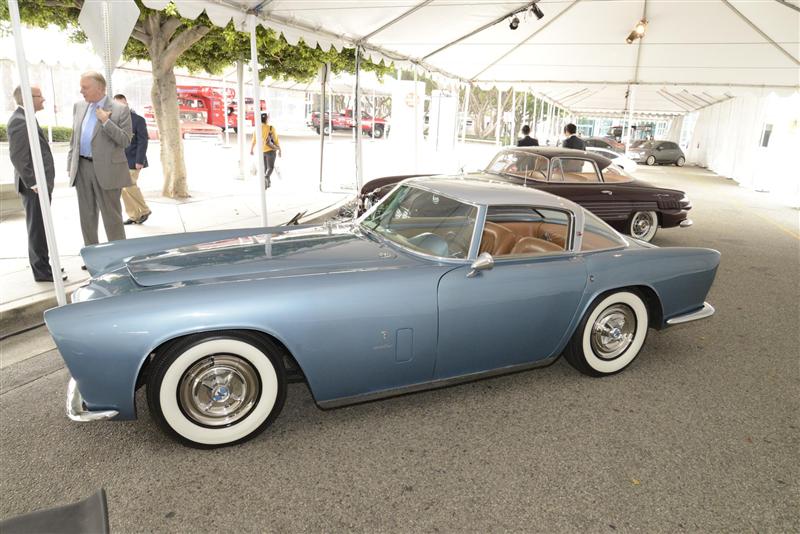1953 Dodge Zeder Storm Z-250
 1953 Dodge Zeder Storm Z-250
1953 Dodge Zeder Storm Z-250
In the early 1950s, Fred Zeder Jr. had an engineering degree and was working in New York doing advertising work as vice president of McCann-Erickson. He was the son of Frederick Zeder of The Three Musketeers (the three famous Studebaker engineers who would later become the core engineer's at Chrysler).

Zeder Jr. was an avid race driver and event competed against Briggs Cunningham using a Chrysler Allard. Soon the desire for a dual-purpose sports car that could compete against the greatest cars on the circuits (including Ferraris, Jaguars, and the Cunninghams) compelled Zeder Jr. to design adn create his own car.
Though his father passed away in 1951, Zeder Jr. still had plenty of connections in the automotive community. One of the connections was Carl Breer, who was working as a consultant for Chrysler after his retirement in 1949. (Carl Breer was also one of the 'Three Musketeers').
Zeder Jr. found addition help with Gene Cassaroll, a racing enthusiast and owner of American Shipper Incorporated. Mr. Cassaroll's business transported Chrysler products around the company. Together, Zeder and Cassaroll formed the Sports Car Development Corporation.

Another individual who joined the team was John Butterfield, who's resume included work for Cunningham and was one of Chrysler's top chassis engineers at the time.
Zeder Jr. envisioned a dual purpose car with swappable bodies. His goal was to create a two seater race car wearing a light weight fiberglass body that could be given an aluminum coupe top by attached four rubber-bushed nuts. The mechanical components of the car included a Dodge HEMI V8 truck engine offering 260 horsepower and 330 ft-lbs of torque. Other parts were sourced from Plymouth and Dodge vehicles, including the brakes, radiators, clutch, fuel tank, rear axle, and steering system. The transmission was a new unit developed by the Spicer Division of Dana Corporation.

The rest of the car was built solely for the car, including the tube space frame (built mostly by Butterfield in his basement), suspension, and the two bodies.
The styling of the car was the work of Hank Kean, who was also working for Chrysler at the time. Kean developed a quarter-scale model of the car and showed it to Virgil Exner, Chrysler's head of Advanced Design. Exner offered some suggestions on the vehicle's design.

In 1952, while on Christmas vacation in Europe, Zeder visited Fiat's Chief Engineer in Turin. Dante Giacosa recommended a visit to Bertone. Though they were busy designing and building the Alfa Romeo BAT series, they agreed to build the body for Zeder's new car. They promised 3 months to finish the car, but instead it took 9 months. Also, the design plans stated a 2+2 seating configuration, but the resulting body was a two-seater. Bertone explained that though it looked good on paper, it would not work in reality.

After the work was completed, the car was taken to Fiat's oval roof track for testing and further development. It was later shown at the Turin Auto Show where the car took first prize. The car was then placed on the SS Andrea Doria and shipped back to New York. Zeder collected the car at the docks and drove it straight to Rockefeller Center. He parked it in front which caused a massive traffic jam. The police had to come and ask him to move it.
The car, called the Zeder Storm Z-250, was taken to Chrysler's design headquarters in Hamtramck in April of 1954. His uncle, Jim Zeder, was the Chief engineer at Chrysler at the time. Fred loaned the car to Jim in hopes the car, or possibly parts of the car, might enter production. For reasons unknown, Jim had the car locked up in the factory's storage for two years. Fred could only guess that Jim was afraid he would be responsible if the project failed, or would not receive credit if it had succeeded. The official reason was that the car was too expensive to produce and would not be profitable.

When Fred received his car, history had passed him over. The Chevrolet Corvette, Ford Thunderbird, and several other cars had captured the heart of America.
Zeder drove the Z-250 of 16 years. He loaned it to the Northwood University where it would stay until 1992. By this point in history, water had somehow leaked into the cylinders. The engine was removed and replaced with a 1965 Dodge V8 with two four-barrel carburetors. After the work was completed, Zeder continued to drive the car in his home in California.
In recent years, the car was on display at the Petersen Automotive Museum and at the 2013 LA Auto Show.
[size=undefined]By Daniel Vaughan | Nov 2013[/size]

Zeder Jr. was an avid race driver and event competed against Briggs Cunningham using a Chrysler Allard. Soon the desire for a dual-purpose sports car that could compete against the greatest cars on the circuits (including Ferraris, Jaguars, and the Cunninghams) compelled Zeder Jr. to design adn create his own car.
Though his father passed away in 1951, Zeder Jr. still had plenty of connections in the automotive community. One of the connections was Carl Breer, who was working as a consultant for Chrysler after his retirement in 1949. (Carl Breer was also one of the 'Three Musketeers').
Zeder Jr. found addition help with Gene Cassaroll, a racing enthusiast and owner of American Shipper Incorporated. Mr. Cassaroll's business transported Chrysler products around the company. Together, Zeder and Cassaroll formed the Sports Car Development Corporation.

Another individual who joined the team was John Butterfield, who's resume included work for Cunningham and was one of Chrysler's top chassis engineers at the time.
Zeder Jr. envisioned a dual purpose car with swappable bodies. His goal was to create a two seater race car wearing a light weight fiberglass body that could be given an aluminum coupe top by attached four rubber-bushed nuts. The mechanical components of the car included a Dodge HEMI V8 truck engine offering 260 horsepower and 330 ft-lbs of torque. Other parts were sourced from Plymouth and Dodge vehicles, including the brakes, radiators, clutch, fuel tank, rear axle, and steering system. The transmission was a new unit developed by the Spicer Division of Dana Corporation.

The rest of the car was built solely for the car, including the tube space frame (built mostly by Butterfield in his basement), suspension, and the two bodies.
The styling of the car was the work of Hank Kean, who was also working for Chrysler at the time. Kean developed a quarter-scale model of the car and showed it to Virgil Exner, Chrysler's head of Advanced Design. Exner offered some suggestions on the vehicle's design.

In 1952, while on Christmas vacation in Europe, Zeder visited Fiat's Chief Engineer in Turin. Dante Giacosa recommended a visit to Bertone. Though they were busy designing and building the Alfa Romeo BAT series, they agreed to build the body for Zeder's new car. They promised 3 months to finish the car, but instead it took 9 months. Also, the design plans stated a 2+2 seating configuration, but the resulting body was a two-seater. Bertone explained that though it looked good on paper, it would not work in reality.

After the work was completed, the car was taken to Fiat's oval roof track for testing and further development. It was later shown at the Turin Auto Show where the car took first prize. The car was then placed on the SS Andrea Doria and shipped back to New York. Zeder collected the car at the docks and drove it straight to Rockefeller Center. He parked it in front which caused a massive traffic jam. The police had to come and ask him to move it.
The car, called the Zeder Storm Z-250, was taken to Chrysler's design headquarters in Hamtramck in April of 1954. His uncle, Jim Zeder, was the Chief engineer at Chrysler at the time. Fred loaned the car to Jim in hopes the car, or possibly parts of the car, might enter production. For reasons unknown, Jim had the car locked up in the factory's storage for two years. Fred could only guess that Jim was afraid he would be responsible if the project failed, or would not receive credit if it had succeeded. The official reason was that the car was too expensive to produce and would not be profitable.

When Fred received his car, history had passed him over. The Chevrolet Corvette, Ford Thunderbird, and several other cars had captured the heart of America.
Zeder drove the Z-250 of 16 years. He loaned it to the Northwood University where it would stay until 1992. By this point in history, water had somehow leaked into the cylinders. The engine was removed and replaced with a 1965 Dodge V8 with two four-barrel carburetors. After the work was completed, Zeder continued to drive the car in his home in California.
In recent years, the car was on display at the Petersen Automotive Museum and at the 2013 LA Auto Show.
[size=undefined]By Daniel Vaughan | Nov 2013[/size]
_________________
We don't care the People Says , Rock 'n' roll is here to stay - Danny & the Juniors - 1958
 Re: 1953 Dodge Zeder Storm Z-250
Re: 1953 Dodge Zeder Storm Z-250
_________________
We don't care the People Says , Rock 'n' roll is here to stay - Danny & the Juniors - 1958
 Re: 1953 Dodge Zeder Storm Z-250
Re: 1953 Dodge Zeder Storm Z-250
_________________
We don't care the People Says , Rock 'n' roll is here to stay - Danny & the Juniors - 1958
 Sujets similaires
Sujets similaires» warren storm
» The Dixie Boys – Rockin’ Storm
» The Firebirds - Taking by storm - Too Hot Too handle - Movin' on
» Dodge Dragster - Dodge Charger dragster funny car - Matchbox Superfast
» LINCOLN 1953 - ELECTRO CAR - MUZINO JAPANESE TIN 1953
» The Dixie Boys – Rockin’ Storm
» The Firebirds - Taking by storm - Too Hot Too handle - Movin' on
» Dodge Dragster - Dodge Charger dragster funny car - Matchbox Superfast
» LINCOLN 1953 - ELECTRO CAR - MUZINO JAPANESE TIN 1953
Permission de ce forum:
Vous ne pouvez pas répondre aux sujets dans ce forum
 Connexion
Connexion


